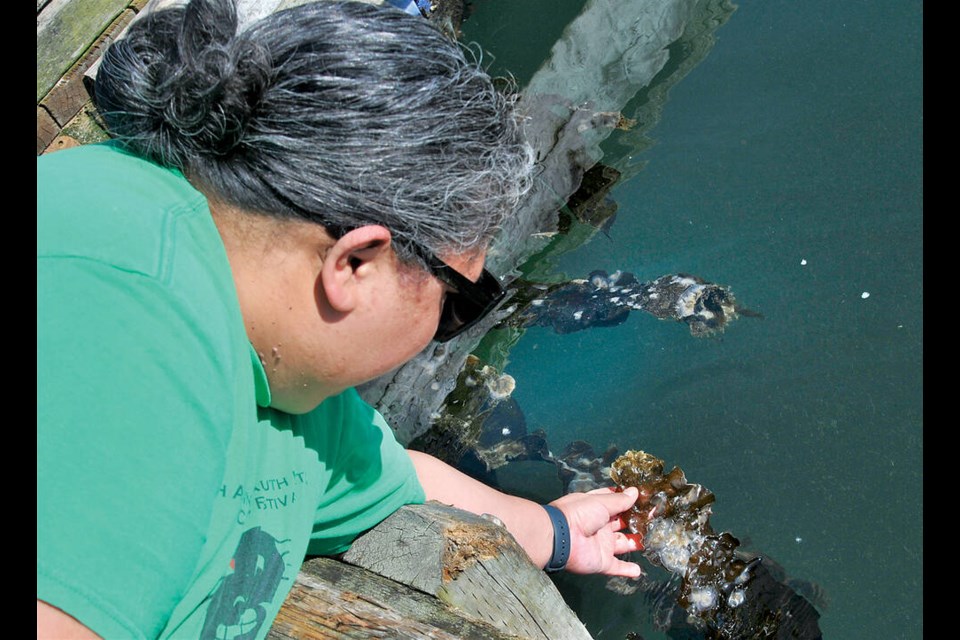Early observations from researchers suggest that new bull kelp are growing in Burrard Inlet waters after nearly being wiped out by industrialization.
The səlilwətaɬ (Tsleil-Waututh Nation)’s treaty, lands and resources department worked with the Kelp Rescue Initiative to plant kelp off Whey-Ah-Wichen/Cates Park in North Vancouver and New Brighton Park in Vancouver over the last two years.
A scuba mission by Fisheries and Oceans Canada in July revealed bull kelp are growing healthy to a reproductive age.
“I think going into this, knowing how restoration has occurred in other areas of the Northeastern Pacific, I was skeptical that we’d find any re-recruitment at all,” said Olivia Rhoades, program co-lead for DFO’s coastal environmental baseline program. “So that’s really neat.”
In 2024, Rhoades and others from the program completed a survey of the types and sizes of kelp and fish in the restoration sites with kelp beds around Stanley Park to compare biodiversity. Preliminary data from July’s survey look promising.
“We’re excited to look at the results,” she said.
‘Trees for the ocean’
Bull kelp is a seaweed that is like “trees for the ocean,” said Michelle George, cultural and technical specialist for Tsleil-Waututh Nation, oxygenating the water and creating a haven for essential species in the marine life ecosystem. The sea plant can reach up to 30 metres tall in their year-long lifespan.
The Kelp Rescue Initiative, a non-profit that helps restore kelp in B.C., and the Tsleil-Waututh Nation noticed the kelp disappearing from most parts of Burrard Inlet, prompting them to apply for project funding to see if restoration of the sea plant was possible.
The City of Vancouver’s sustainability team pitched in $110,000 to bring the plan into fruition.
Planting trials started in 2023, in which baby kelp were placed on pebbles and scattered into the water using a boat, but the attempt saw little success.
“It was evident pretty quickly that those little pieces of gravel aren’t enough to keep those kelp in place once they reach a certain size and become too buoyant basically,” said Jasmin Schuster, program manager of the Kelp Rescue Initiative. “So it just all got washed around.”
After the trial, the initiative then grew baby kelp on bigger rocks and ceramic tiles in a nursery for up to nine weeks at the Pacific Science Enterprise Centre in West Vancouver. They then glued the kelp to natural rock and bolted others to cinder blocks so divers could deploy them on the sea floor over the spring and summer last year.
This method worked really well, seeing kelp grow and reach its reproductive stage, Schuster said, at which point, the seaweed releases spores into the area, opening the door for natural growth.
Angela Danyluk, manager of climate adaptation and equity at the City of Vancouver, said bull kelp has environmental benefits.
“Bull kelp help protects our shoreline through managing erosion. It attenuates waves, but it also provides habitat for juvenile fish and crab,” Danyluk said. “It also helps just to have a healthy ecosystem, which we all can enjoy.”
But growing the sea plant can be challenging as it needs specific conditions to grow like the right amount of sun, water flow and space, George said.
With rising sea levels and changing water temperatures, it gets complicated.
“There’s more algae blooms within the inlet,” George said. “As much as we try to adapt to what we know, the environment around us is also changing.”
The plant was traditionally used by Tsleil-Waututh people for food preparation and preservation and it helped paddlers read water currents.
Before Europeans arrived, bull kelp was so thick that people had trouble paddling and wading through it, George said.
“There’s stories where you could walk across the backs of salmon and never touch water,” she said. “So all of these areas were heavily abundant in resources, and then [industrialization] and colonization happened.”
Dynamite fisheries, heavy clear cutting, logging booms and oil refineries all played a part in wiping out kelp, sea grass and marine life in general, George said.
As the project moves in a growing trajectory, Danyluk said it’s important for local governments to work with First Nations in restoration projects.
“This is part of reconciliation and action by supporting them in their interest,” Danyluk said. “But also, we benefit from learning more through soil issues, just because these near-shore ecosystems are very important to the health and well-being of our city.”
George said she hopes the restoration projects will help others learn more about the water and natural environments surrounding them.
“They’re like trees of the water, they’re helping us out and unfortunately they’ve been devastated by industry and other pollution,” George said. “So just taking the time to learn about it.”
Researchers are hoping to share the survey’s full findings soon, Rhoades said.
Abby Luciano is the Indigenous and civic affairs reporter for the North Shore News. This reporting beat is made possible by the Local Journalism Initiative.
https://bsky.app/profile/abbyluciano.bsky.social
Want to stay updated on North Vancouver and West Vancouver news? Sign up for our free daily newsletter.




